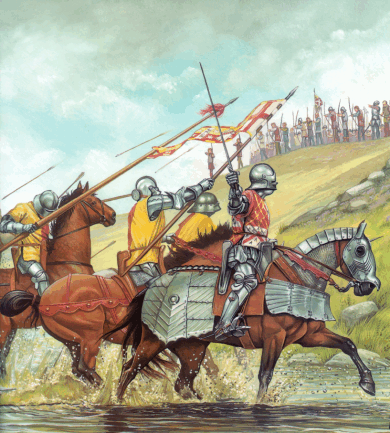England's uneasy period of peace since the First Battle of St. Albans came to end on 23 September 1459 at the Battle of Blore Heath in Staffordshire.
BACKGROUND
Queen of England, Margaret of Anjou, had been growing in animosity towards Richard, Duke of York, and his supporters, Earl of Salisbury and Earl of Warwick. The Yorkist commanders were spread across the land with York at Ludlow in Shropshire, Salisbury at Middleham,Yorkshire and Warwick in Calais.
Troops were being mustered on both sides and Salisbury took his men south to link up with York at Ludlow. The royal army was moving to Ludlow from Nottingham but Anjou, hearing of Salisbury's movements, instructed James Tuchet, Lord Audley, to intercept.
BATTLE
Audley chose the open ground of Blore Heath to press home his advantage of 10,000 men and cavalry. Salisbury took up defensive positions by digging a trench to his rear and fortified the front line with stakes. Audley took up position behind a steep, wide and fast-flowing stream that was out of range of Salisbury's archers.
Salisbury prompted Audley into a cavalry charge by ordering a portion of his line to retreat. Audley fell into the trap as Salisbury ordered his men to return and attack the cavalry crossing the stream. The Lancastrian infantry successfully crossed the stream in a second attack and a fierce melee ensued.
 |
| Lord Dudley leads the Lancastrian attack |
Audley died in the fighting and his command was left to John Sutton, Lord Dudley, who led 4,000 infantrymen into the third and final wave. Dudley's cause soon deteriorated when 500 of his own men joined the enemy and attacked the Lancastrians. Dudley's men soon fled the battle and they were cut down by Salisbury's men.
Salisbury, despite having half of the men, was able to take advantage of the land and his military tactics, to kill 2,000 Lancastrians to the loss of his 1,000 men. But Salisbury was aware of an approaching royal army, with Anjou five miles away at Eccleshall and Henry VI 10 miles away.
Salisbury showed further ingenuity in his undetected retreat from Blore Heath when he instructed a friar to fire the remaining battlefield artillery throughout the night. The royal forces of 15,000 men advanced to Blore Heath and were greeted the next morning by the lone friar. The friar replied to Lancastrian demands of why he stayed on the battlefield all night by saying he was "afraid to leave it."
York would later met up with Salisbury and Warwick at Worcester to prepare for a fight with the Lancastrians that came at Ludford Bridge on 12 October 1459.

No comments:
Post a Comment